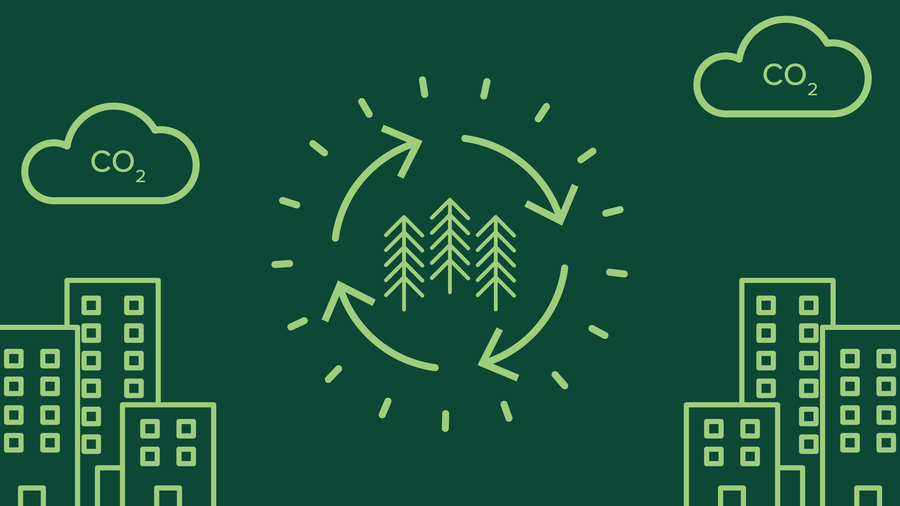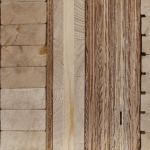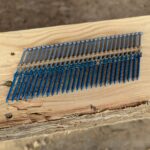Expert Tips
What Net Zero Means in the Building Construction Industry
Demystifying the term ‘net zero,’ and how wood structural materials can help move buildings toward a net-zero carbon goal

For more information on whole building life cycle assessment, biogenic carbon and carbon storage, and environmental product declarations, visit our Sustainability page. View a complete list of sustainability resources here.
What is Net Zero?
The phrase net zero has become common in the building industry. Recently constructed buildings are touted as net zero, designers and owners strive to achieve net zero, and policies are in place and being created that require net-zero construction. Everyone seems to want a net-zero outcome, but there is lack of consensus on what the term means and how to get there.
In the not-so-distant past, net zero within the building industry was a term associated with operational energy—i.e., used during a building’s operation to power, heat, and cool the structure. With improvements in energy efficiency, renewable energy options, and more efficient design techniques, many buildings have been able to achieve net-zero operational energy, where no off-site energy is required for standard performance, and net-zero operational carbon, where associated carbon emissions are zero through the use of renewable energy sources. These buildings have frequently been called net-zero energy buildings or net-zero buildings. Occasionally, net zero has also been used to describe performance goals, such as water or waste usage by the building’s occupants. For example, in a net-zero water building, the amount of water from alternative sources plus the water returned to the original source is equivalent to the amount of water used during operation of the building in a year. Similarly, a net-zero waste building would result in no waste going to landfills or incinerators.1
More recently, net zero has been discussed in relation to the overall carbon impact of a building, which includes both operational carbon and embodied carbon.2 Embodied carbon refers to greenhouse gas (GHG) emissions associated with the manufacturing, transportation, installation, repair and maintenance, and deconstruction and disposal of materials within a structure.3,4 Embodied carbon is often counted separately from operational carbon, so it is possible to set net-zero embodied carbon goals. When considering operational and embodied carbon together, the goal would be net-zero total carbon.
Another intricacy in the net-zero carbon discussion is carbon offsets (also called carbon offset credits or offset credits), which can be purchased to compensate for carbon emissions.5,6 These offsets are then subtracted from the carbon total in order for the structure to claim net-zero carbon.7
How Wood Products Can Contribute to Lower Embodied Carbon
One of the most straightforward ways to reduce the embodied carbon of a structure is to utilize materials that have low embodied carbon. This means finding materials that emit less GHGs into the atmosphere during production, installation, and deconstruction. Over and over, it has been shown that wood materials have lower embodied carbon than functionally equivalent alternatives.8
Part of this is due to the use of renewable biomass fuels (i.e., bark and other residual wood fibers) in place of fossil fuels during product manufacture. In American Wood Council (AWC) member facilities, which represent over 86% of the structural wood products industry, more than 70% of the energy used in wood product manufacturing comes from biomass.9 Based on the “-1 in/+1 out” biogenic carbon accounting framework outlined in ISO 2193010 for biobased materials originating from sustainably managed forests, biomass energy is considered carbon neutral, so the associated carbon emissions don’t contribute to the building’s embodied carbon.11
Additionally, because wood is a renewable, biobased material, it contains biogenic carbon,12 which is carbon that was removed from the atmosphere through the process of photosynthesis during the tree’s growth. That carbon continues to be stored in the wood, keeping it out of the atmosphere for the lifetime of the wood product. When performing a whole building life cycle assessment (WBLCA), it is helpful to account for embodied carbon and biogenic carbon separately since they represent different sources of carbon. However, when looking at the full carbon impact of a building, the negative biogenic carbon value is often summed with the positive embodied carbon value. If there is at least as much biogenic carbon stored in the wood products as there is embodied carbon released throughout the building’s life, the structure could be considered net-zero embodied carbon. For this definition of net zero, it is important to remember that, although the product will indeed store biogenic carbon over the lifetime of the building, eventually, at the end of the building’s life, some or all of the stored carbon will be ‘released’ from the system,13 at which point it is no longer available to offset the embodied carbon emissions.
The Real Goal of Net Zero Carbon
Because of the numerous ways the term net zero is used, building owners and designers should be clear which type of net zero they’re aiming for, both during the design phase to ensure their efforts are focused appropriately, and in sharing their accomplishments with the public to eliminate confusion. Whether discussing operational or embodied carbon, at the end of the day, the goal in net-zero carbon construction is the same: to create a built environment that is less carbon-intensive. This can be accomplished through a variety of strategies, including the use of wood construction materials. Use of WBLCA can help owners and designers analyze buildings through a carbon-conscious lens and make material choices that lower carbon emissions. Although net zero is a lofty goal that there is no simple way to achieve, the use of wood in construction is a proven carbon-reduction strategy.
Additional Resources
Hall, E.S., (2020, September). How to Calculate the Wood Carbon Footprint of a Building.
KL&A Engineers and Builders., Adolfson & Peterson. (2021, July). Platte Fifteen Life Cycle Assessment.
WoodWorks – Wood Products Council. (2021, October). Building Sustainably: From Forestland Management to Carbon-Positive, Healthy Buildings.
Think Wood. Net Zero Buildings.
1 U.S. Department of Energy. (2017, August). Federal Existing Buildings Handbook for Net Zero Energy, Water, and Waste.
2 O’Conner, J. (2020, February). What can we do about embodied carbon? Canadian Architect.
3 SPOT UL. (2020, August). Embodied vs Operational Carbon.
4 Carbon Leadership Forum. (2020, December). Embodied Carbon 101.
5 Carbon Offset Guide. What is a Carbon Offset?
6 CarbonCredits.com. How to Make Money Producing and Selling Carbon Offsets.
7 There is also an emerging interest in the sale of credits for carbon stored within mass timber buildings. For additional information see: Ta, K. (2022, September). Aureus Earth and the University of Washington Execute Ground-Breaking Carbon Offset Transaction for a Mass Timber Building. Green Canopy NODE. (2022). Pioneering the First Mass Timber Carbon Removal Methodology.
8 Sathre, R., O’Connor, J. (2010, October) A Synthesis of Research on Wood Products & Greenhouse Gas Impacts 2nd Edition.
9 American Wood Council, (2020, December). Environment, Energy & Safety Report Industry Progress Report.
10 International Organization for Standardization. (2017). ISO 29130: 2017 Sustainability in Buildings and Civil Engineering Works – Core Rules for Environmental Product Declarations of Construction Products and Services, Section 7.2.7.
11 Among the resources on this topic, a US EPA Policy Statement “reflect[s] the carbon-neutrality of forest bioenergy and recognize[s] biomass as a renewable energy source, provided the use of forest biomass for energy production does not cause conversion of forests to non-forest use.” U.S. Environmental Protection Agency. EPA’s Treatment of Biogenic Carbon Dioxide (CO2) Emissions from Stationary Sources that Use Forest Biomass for Energy Production.
12 For information on carbon storage in wood products, see this WoodWorks article.
13 How to include biogenic carbon in an LCA is discussed in more depth in this WoodWorks article.



